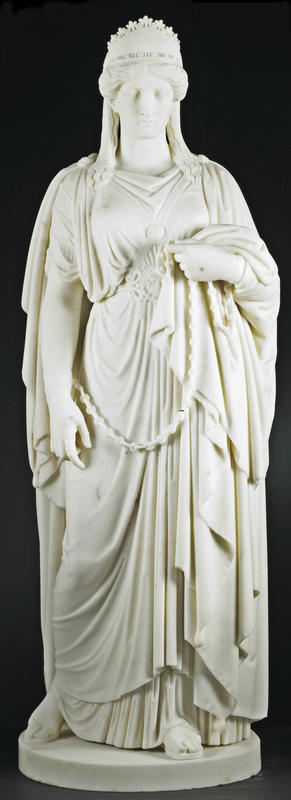More about Zenobia in Chains
- All
- Info
- Shop

Contributor
It’s only right that one of the few female neoclassical master sculptors in existence would cover one of the few notable female monarchs in ancient history: Zenobia, queen of Palmyra, a Roman colony located in present-day Syria.
Before she was Palmyra’s monarch, she was the wife of Odenathus, who recently liberated Palmyra from Persian clutches in the year 267. About eleven to twelve years later, he and his eldest son Herodes were assassinated. Right then and there, Zenobia did what Hatshepsut did before her and Cixi did after her and installed herself as regent with her son, Wahballat, as figurehead. During his reign, Odenathus was content to stay under the shadow of Rome’s rule as a client state. Zenobia, having bigger ambitions and cajones than her husband ever had, would have none of that. In 269 she marched down to conquer Egypt and Asia Minor (present-day Turkey), declaring Palmyra independent from Roman rule.
Unfortunately, it wasn’t meant to last. Rome quickly retaliated, sending Aurelian, one of their finest generals, East to deal with the insurrection. He defeated her in battles at Antioch and Emesa, then went straight for Palmyra. Wahballat and Zenobia were subsequently captured while crossing the Euphrates and surrendered in 273. A year later, Palmyra was eradicated after an attempt to revolt and the pair were paraded during Aurelian’s triumph procession. Hosmer’s sculpture shows Zenobia as she believed she looked during this parade.
When Zenobia was exhibited in London in 1852 it became one of Hosmer’s most famous works, enough that one of Chicago’s largest developers bought a version of it for his home. The developer, Potter Palmer, was a merchant and real estate promoter responsible for building much of Lake Shore Drive and rebuilding the downtown district of Chicago after the 1871 fire. Multiple bust versions of the piece were made for mass consumption, like Hercules’s likeness in the Disney movie after he slew the hydra.
Sources
- Britannica, The Editors of Encyclopaedia. 2014. “Zenobia.” Encyclopædia Britannica. Encyclopædia Britannica, inc. April 3, 2014. https://www.britannica.com/biography/Zenobia.
- Britannica, The Editors of Encyclopaedia. 2018. “Potter Palmer.” Encyclopædia Britannica. Encyclopædia Britannica, inc. May 17, 2018. https://www.britannica.com/biography/Potter-Palmer.
- Britannica, The Editors of Encyclopaedia. 2018. “Harriet Goodhue Hosmer.” Encyclopædia Britannica. Encyclopædia Britannica, inc. October 5, 2018. https://www.britannica.com/biography/Harriet-Goodhue-Hosmer.













